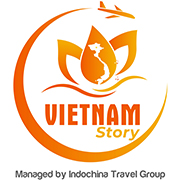Vietnam, a Southeast Asian jewel with lush landscapes and a vibrant culinary scene, is renowned globally for its incredible variety of tropical fruits. For travelers, especially those visiting from India, exploring the colourful markets brimming with exotic produce is an essential part of the travel in Vietnam experience. From bustling city markets in Hanoi or Ho Chi Minh City to the tranquil countryside orchards of the Mekong Delta, the abundance and diversity of fruits in Vietnam are a delicious testament to the country’s fertile land and favourable tropical climate. This guide delves into the fascinating world of Vietnamese fruits, exploring their cultural significance during traditions like Tet, their essential role in Vietnamese cuisine, and the unique characteristics and eating methods that make them so beloved.
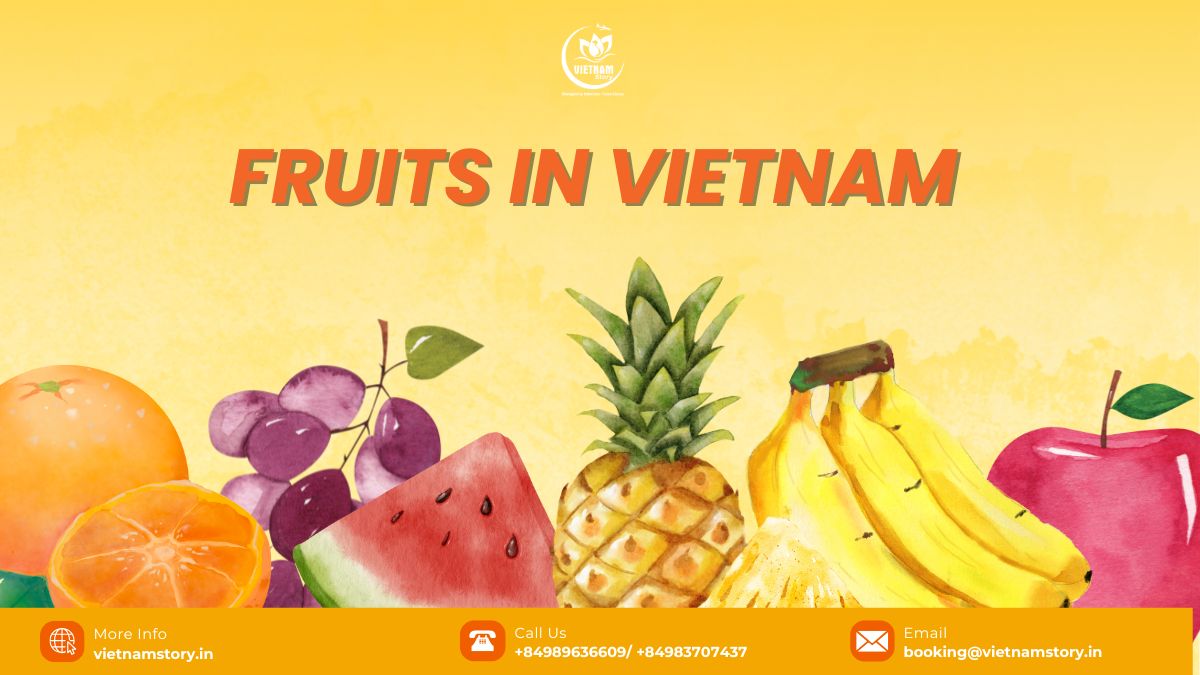
The Importance of Fruits in Vietnam: More Than Just a Snack
Fruits are far more than just a sweet treat in Vietnam; they are integral to daily life, a cornerstone of the agricultural economy, and a significant element of the nation’s cultural identity and Vietnamese culture.
Dietary Staple in Vietnamese Cuisine
Vietnamese cuisine incorporates fruits in Vietnam in countless ways. They are enjoyed fresh as snacks and desserts, providing essential vitamins and minerals. Beyond simple consumption, many fruits are key ingredients in savoury dishes, adding unique sweetness, acidity, and texture. Green Mango salad (gỏi xoài) is a prime example, showcasing the tangy flavour of unripe mangoes often enjoyed with chili salt. Others, like Star Fruit (Khế), feature in home-style sweet and sour fish soups (canh chua cá). Coconut milk, derived from the ubiquitous coconut, forms the base of countless curries and sweet soups (chè).
Economic Powerhouse: Fruits in Vietnam’s Agriculture
The fruit sector is a major contributor to Vietnam’s agricultural economy and Vietnamese Agriculture. The country is a leading exporter of several tropical fruits, including Mangoes (Xoài), Dragon Fruit (Thanh Long), Durian (Sầu Riêng), and Longans (Nhãn). This export success provides livelihoods for millions of farmers, particularly in the fertile Mekong Delta, often called the “fruit basket” of Vietnam, famed for its orchards laden with mangoes, Pomelos (Bưởi), Rambutans (Chôm Chôm), and coconuts.
READ MORE: Embracing The Flavors Of Vietnam
Cultural Significance: Symbolism and the Tet Tradition
Fruits in Vietnam are deeply interwoven with cultural traditions, especially the Tet (Lunar New Year) celebration. The display of five fruits on the ancestral altar (mâm ngũ quả) is crucial country-wide, though the specific fruits vary by region based on availability and symbolism. Fruits like Pomelos (Bưởi), symbolizing abundance, red Watermelons (Dưa Hấu) for luck, and decorative Kumquat (Quất/Tắc) trees representing prosperity are prominently featured. The vibrant colours and round shapes of many fruits are considered auspicious, making them essential offerings and gifts during this most important holiday in Vietnam.
A Deep Dive into the Kingdom of Fruits in Vietnam
Vietnam’s diverse climate, ranging from the tropical south to the more temperate north, allows for the cultivation of an astonishing array of fruits in Vietnam. Let’s explore some of the must-try varieties, covering their key attributes like appearance, taste, season, origin, and importantly, how to eat them!
Must-Try Tropical Fruits: Year-Round & Seasonal Delights
These fruits thrive in Vietnam’s warm, humid climate. While some have peak seasons, many can be found in markets and from street vendors throughout the year.
Mangosteen (Măng Cụt)

- Appearance: Round fruit with a thick, deep purple rind. Inside reveals soft, white, segmented flesh.
- Taste/Texture: Exquisite sweet and tangy flavour, soft, juicy flesh. Often considered one of the most delicious exotic fruits in Asia.
- Season/Availability: Peak season is relatively short, typically from May to August. Highly anticipated by locals.
- Region of Origin: Primarily grown in the South, including the Mekong Delta (Ben Tre, Tien Giang).
- How to Eat: Gently squeeze the fruit around the middle until the skin cracks. Twist the shell apart. Pull out a segment (pod) and enjoy. Larger pods may contain a seed. Also used in a popular Southern savoury salad (gỏi măng cụt).
- Price Range: 2.5 – 3.5 USD/kilogram
Star Fruit (Khế)

- Appearance: Waxy, golden-yellow skin when ripe, with five distinct ridges. Oval shape.
- Taste/Texture: Refreshing, juicy, with a tangy, slightly sweet taste, like a mix of grape and apple.
- Season/Availability: Trees bloom twice a year, so often available year-round, especially in the Mekong Delta. Peak seasons around Oct-Nov and Feb-Mar.
- Region of Origin: Common in the South, particularly the Mekong Delta.
- How to Eat: Rinse the fruit well. Slice horizontally to reveal perfect star-shaped pieces. The thin, waxy skin is edible. Often eaten fresh or used as a key ingredient in canh chua cá (sweet and sour fish soup).
- Price Range: 1 – 1.5 USD/kilogram
Rambutan (Chôm Chôm)
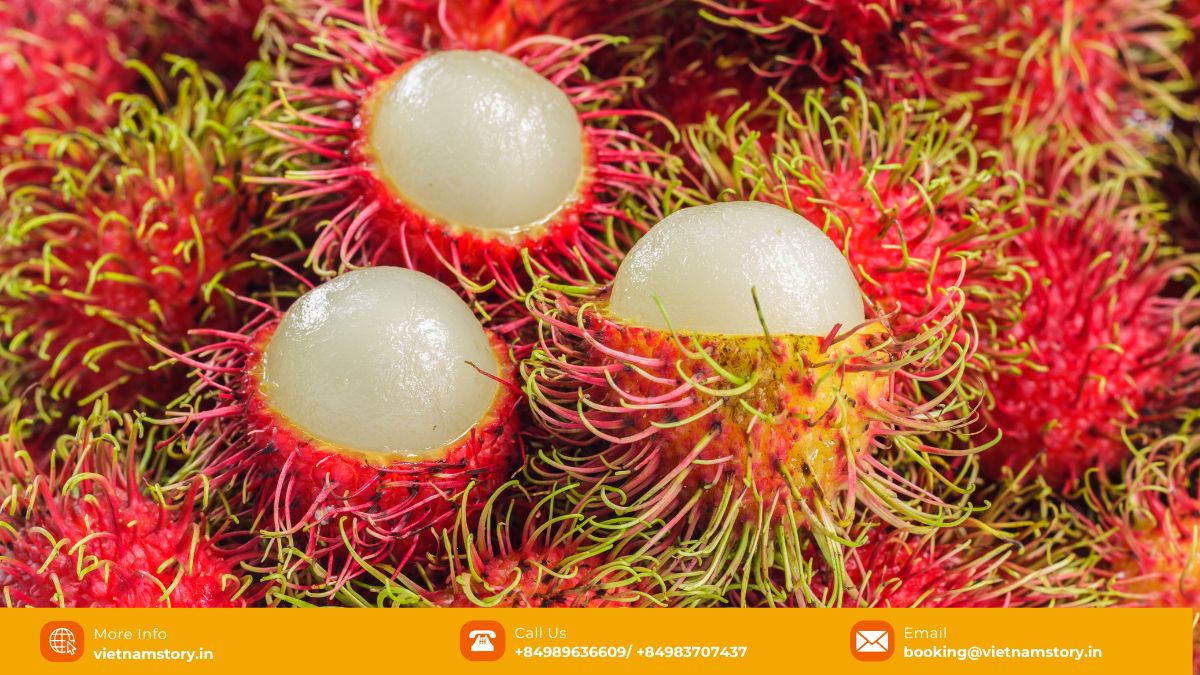
- Appearance: Oval fruit covered in soft, pliable, red (sometimes yellow) spines, resembling ‘messy hair’ (the meaning of Chôm Chôm). This hairy exterior is unique.
- Taste/Texture: Translucent white flesh inside is sweet and mildly sour, similar to a grape or lychee.
- Season/Availability: Harvested twice a year, commonly found in summer (around May-Aug) and sometimes winter.
- Region of Origin: Widely grown in the South.
- How to Eat: Give the fruit a slight pinch and twist, or use a knife to slit the skin halfway around, then pop the flesh out. Discard the seed inside. A refreshing snack.
- Price Range: 0.7 – 1.2 USD/kilogram
Longan (Nhãn Lồng)

- Appearance: Small, round fruit with a thin, brittle, light brown skin. Inside is translucent white flesh surrounding a single hard, shiny black seed, resembling an eye (hence ‘Dragon’s Eye’).
- Taste/Texture: Very sweet, juicy flesh, slightly muskier than lychee.
- Season/Availability: Main season is generally July to September/October. Hung Yen province in the North is famous for its Longan.
- Region of Origin: Grown in both North and South, but Hung Yen variety is prized.
- How to Eat: Easily peel off the thin skin with your fingers. Pop the fleshy fruit in your mouth and eat around the seed. Enjoyed fresh, often with tea, or in a popular dessert soup with lotus seeds (chè hạt sen nhãn lồng).
- Price Range: 1 – 2 USD/kilogram
Pomelo (Bưởi)

- Appearance: Large citrus fruit, often round or slightly oblong. Thick green or yellow rind with very thick white pith beneath. Flesh can be pale yellow or pink, composed of juice-filled sacs.
- Taste/Texture: Milder and often sweeter than grapefruit, less bitter. Juicy sacs provide a unique texture.
- Season/Availability: Available most of the year, but prominently displayed during Tet.
- Region of Origin: Common in the Mekong Delta (Ben Tre’s Bưởi Da Xanh is famous) and some Northern provinces.
- How to Eat: Cut through the thick rind and pith. Peel off the pith from the flesh segments (the pith is bitter). Separate the segments and remove the membrane around them. Eat the juicy sacs. Popular in savoury salads like gỏi bưởi.
- Cultural Significance: Symbolizes prosperity and abundance, a key fruit for Tet offerings.
Dragon Fruit (Thanh Long)

- Appearance: Striking oval fruit with thick, leathery, bright fuchsia/pink skin and wavy green-tipped extensions. Flesh inside is typically white or sometimes purple/red, dotted densely with tiny edible black seeds.
- Taste/Texture: Surprisingly mild, almost watery taste, subtly sweet. Texture is similar to kiwi but less flavourful.
- Season/Availability: Grown widely, often available year-round, peak around Oct-Nov.
- Region of Origin: Widely grown in the Mekong Delta and Binh Thuan province.
- How to Eat: Simply slice the fruit (lengthwise or crosswise) and peel or cut away the thick rind. Cube the flesh and eat. Often served at the end of a meal as a refreshing palate cleanser.
- Price Range: 1 – 1.5 USD/kilogram
Mango (Xoài)
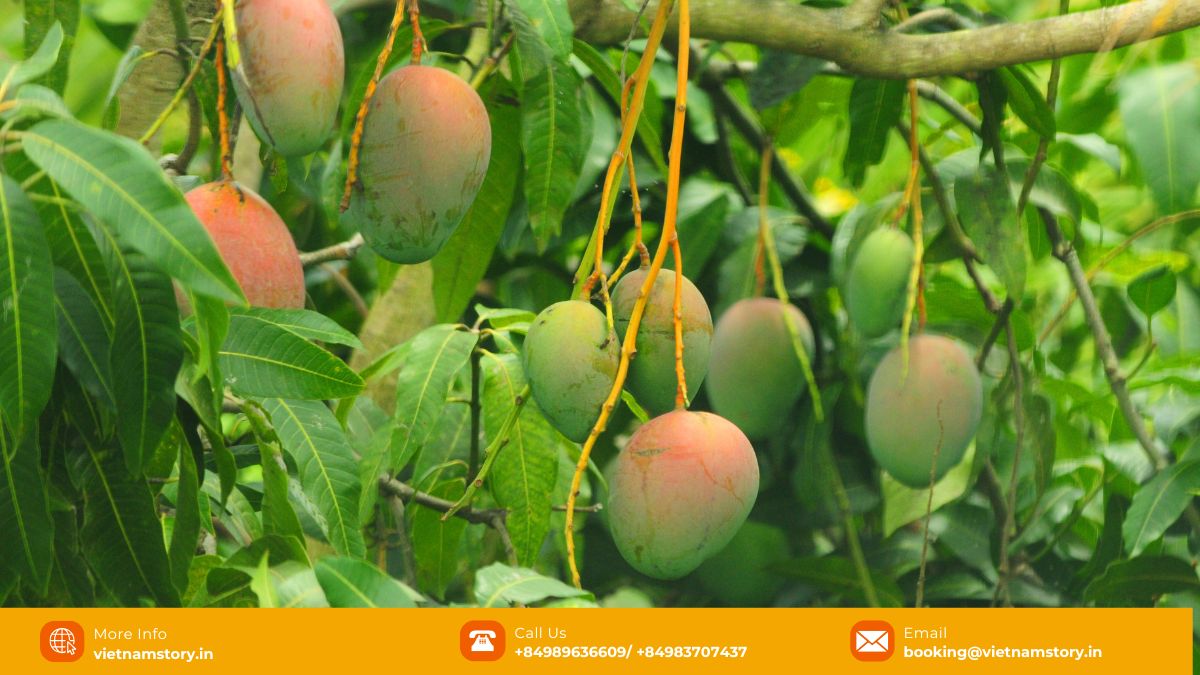
- Appearance: Varies by type, from green to golden yellow/orange skin when ripe. Flesh is typically golden yellow.
- Taste/Texture: Ripe mangoes are aromatic, juicy, and very sweet. Green mangoes are sour and crunchy.
- Season/Availability: Many varieties mean mangoes are available much of the year, peak season generally March to May/June.
- Region of Origin: Predominantly the Mekong Delta, Southern Vietnam.
- How to Eat: For ripe mangoes: slice lengthwise around the large flat pit, score the flesh in a criss-cross pattern without cutting the skin, then push the skin inside-out to make cubes pop up. Alternatively, peel and slice. Green mangoes are typically shredded for salad (gỏi xoài) or sliced and eaten dipped in chili salt – a popular Vietnamese snack.
- Price Range: 0.7 – 2.5 USD/kilogram
Rose Apple (Quả Roi – North / Quả Mận – South)

- Appearance: Bell-shaped fruit with thin, waxy skin, usually red but sometimes green or white.
- Taste/Texture: Crispy, watery texture similar to a melon. Mildly sweet, refreshing taste, sometimes described like unripe pear with a hint of rosewater.
- Season/Availability: Found most of the year, especially in the South.
- Region of Origin: Common in the South of Vietnam.
- How to Eat: Simply rinse and eat like an apple, munching around the small core (avoid the very base). Can also be sliced. Often enjoyed with a little chili salt.
- Price Range: 1 – 2 USD/kilogram
Star Apple (Vú Sữa)

- Appearance: Round, smooth, shiny skin, typically violet or green. Roughly the size of an orange.
- Taste/Texture: Inside flesh is white, soft, juicy, and fragrantly sweet with a milky juice (hence the Vietnamese name Vú Sữa – ‘mother’s milk’). The skin and rind are bitter.
- Season/Availability: Generally in season around February to March.
- Region of Origin: Orchards found in the Mekong Delta and Central Vietnam.
- How to Eat: Two local ways: 1) Cut in half and scoop out the flesh with a spoon (avoid the large, inedible seeds). 2) Soften the fruit by gently rolling and pressing it in your hands to release the juice inside, then puncture a small hole in the bottom and suck out the sweet, milky liquid.
- Price Range: 2.5 – 3 USD/kilogram
Guava (Ổi)

- Appearance: Pear-shaped or round, light green, sometimes bumpy skin. Flesh can be white or pink with many small, hard seeds.
- Taste/Texture: Light, slightly herbal, mildly sweet and sour taste. Texture is crunchy, especially when slightly unripe.
- Season/Availability: Available year-round.
- Region of Origin: Widely grown throughout Vietnam.
- How to Eat: Wash well. Slice into wedges and eat, including the skin and seeds (though some prefer to scoop seeds out). Most popularly eaten slightly unripe, cut into chunks, and dipped in chili salt (muối ớt).
Passionfruit (Chanh Leo)

- Appearance: Round or oval, typically with tough purple or yellow rind. Roughly tennis ball sized.
- Taste/Texture: Inside contains juicy sacs filled with tart, aromatic, flavourful pulp and edible crunchy black seeds. Refreshing sharp/tangy taste.
- Season/Availability: Found in most seasons, May to December is common.
- Region of Origin: Grown in various regions, including the Central Highlands.
- How to Eat: Cut the fruit in half. Scoop out the yellow pulp and seeds with a spoon. Rarely eaten plain due to tartness. Commonly used to make juice (nước chanh leo), added to yogurt with shaved ice (sữa chua chanh leo), or used in desserts and sauces.
- Price Range: 0.5 – 1 USD/kilogram
Durian (Sầu Riêng)

- Appearance: Large, heavy fruit covered in a thick, hard, formidable green or brownish rind with sharp thorns. Inside are large pods of creamy, pale yellow to deep golden flesh.
- Taste/Texture: Famous for its incredibly strong, pungent aroma that is offensive to some and beloved by others. The texture is rich, smooth, and custard-like, melting in the mouth. Flavour is complex, intensely savoury-sweet.
- Season/Availability: Main season is typically March to May/June, with variations.
- Region of Origin: Primarily grown in the South and Mekong Delta (Ri6 variety is famous), Central Highlands.
- How to Eat: Due to the tough, thorny exterior and strong smell, it’s best to ask the vendor to open it for you. Eat the creamy flesh pods. Popular in desserts like Thai sweet soup (chè Thái), with sticky rice (xôi sầu riêng), or in pastries like bánh pía (durian-filled pastry). Note: Fresh durian is often banned on public transport and flights due to its smell.
- Price Range: 2.35 to 11.40 USD/kilogram (can vary widely by variety like Ri6 or Monthong).
Jackfruit (Mít)

- Appearance: Huge, potentially the world’s largest tree-borne fruit, with bumpy or ridged green/yellowish skin. Inside contains numerous yellow, fleshy bulbs (arils) surrounding seeds, embedded in fibrous material. Can be very sticky (latex).
- Taste/Texture: Ripe flesh bulbs are sweet with a unique, slightly chewy or stringy, sometimes gummy texture. Flavour is sometimes compared to a mix of banana, pineapple, and mango.
- Season/Availability: Common fruit, peak season often July to August.
- Region of Origin: Grown widely across Vietnam (North, Central, South).
- How to Eat: Difficult and messy to open due to size and latex. It’s highly recommended to buy pre-cut portions from vendors or markets. Pull out the yellow fleshy bulbs and eat, discarding the seed within each bulb (seeds can be boiled/roasted and eaten). Also found in mixed fruit bowls (hoa quả dầm) or dried as chips (mít sấy). Young, unripe jackfruit is used as a savoury vegetable in cooking.
- Price Range: 1.5 – 4 USD/kilogram
Other Notable Fruits
- Banana (Chuối Tay / Lady Finger Banana): Smaller, sweeter than typical Cavendish. Widely available year-round. Peel and eat. 0.7 – 1.5 USD/kilogram.
- Lychee (Vải): Similar to rambutan but smooth red skin. Very sweet and fragrant. Short season, mainly summer (May-June). Peel skin, eat flesh, discard seed. Famous from Bac Giang (North).
- Custard Apple (Mãng Cầu / Na): Bumpy green skin, soft, sweet, creamy white flesh with many black seeds. Peel or break open, scoop/eat flesh. Season May-Aug. 1.5 – 2 USD/kilogram.
- Watermelon (Dưa Hấu): Essential during Tet for good luck (red colour). Eaten fresh, juiced. Widely available.
- Gac Fruit (Gấc): Bright red fruit primarily used for its pulp and seed membranes to colour and flavour sticky rice (xôi gấc) for special occasions like Tet and weddings, especially in the North. Short harvest season.
Citrus Fruits: Zesty and Refreshing
Citrus fruits add a vibrant, tangy dimension to the Vietnamese fruit landscape.
Kumquat (Quất / Tắc)

- Appearance: Tiny, oval orange fruit.
- Taste/Texture: Unique in that the rind is sweet and edible, while the center pulp is tart/sour.
- Season/Availability: Grown widely, particularly visible during Tet.
- Region of Origin: Widespread. Central and South regions often use them year-round.
- How to Eat: Often eaten whole (rind and all) for a sweet-tart burst. Also used in drinks, marmalades, or candied. Potted kumquat trees are essential decorations for Tet, symbolizing good luck and fertility.
Lime (Chanh)
Small, green limes are indispensable in Vietnamese Cuisine. Squeezed over countless dishes (like Phở) and used extensively in dipping sauces (like nước chấm) to provide a crucial sour balance.
Orange (Cam)
Varieties like the juicy Cam Sành (often juiced) and sweeter Cam Xoàn are popular. Eaten fresh or juiced.
READ MORE: A full guide to Vietnam’s weather
Practical Tips for Trying Fruits in Vietnam
To make the most of your fruit exploration during your Vietnam tour:
- Where to Buy: Look for fresh fruits in Vietnam at bustling local markets like Ben Thanh Market (Ho Chi Minh City) or Dong Xuan Market (Hanoi), smaller neighbourhood markets, roadside stalls, and even from bicycle vendors. Supermarkets also offer fruits, often at fixed prices.
- How to Choose: Look for fruits with vibrant colour, that feel heavy for their size, and are free from major bruises or soft spots. For some fruits like mangosteen or star apple, a gentle squeeze can indicate ripeness. Don’t hesitate to ask vendors for help selecting ripe ones (‘chin’ means ripe).
- Bargaining: At local markets and street stalls, bargaining is common. Have an idea of the general price range (some listed above in USD for reference) and be polite. Bringing small denominations of cash (Vietnamese Dong) is helpful.
- Seasonality Matters: While many fruits are available year-round, fruits taste best and are cheapest during their peak season. Ask locals or your guide what’s currently in season.
- Wash Before Eating: Always wash fruits thoroughly under running water before consuming, especially if eating the skin.
- Bringing Fruits Home: Be aware of customs regulations. Fresh Durian and often Jackfruit are prohibited on airplanes due to their strong smell. Consider buying dried fruit products (like dried mango, jackfruit chips – mít sấy) as souvenirs – they travel well and are widely available.
Preserving the Bounty: Traditional Techniques
To extend the enjoyment of fruits in Vietnam beyond their fresh seasons, various preservation techniques are used:
- Drying (Sấy khô): Common for mangoes, bananas, longans, jackfruit, creating chewy, sweet snacks.
- Candying (Làm mứt): Creates sweet treats called Ô Mai (in the North) or Mứt (general term), often from kumquats, ginger, coconut, tamarind, star fruit. Especially popular during Tet.
- Pickling (Ngâm chua): Green mangoes, star fruit, mustard greens with fruit elements are pickled, creating tangy side dishes or condiments.
- Jam making (Làm mứt dẻo): Preserving fruits like pineapple and strawberries into jams.
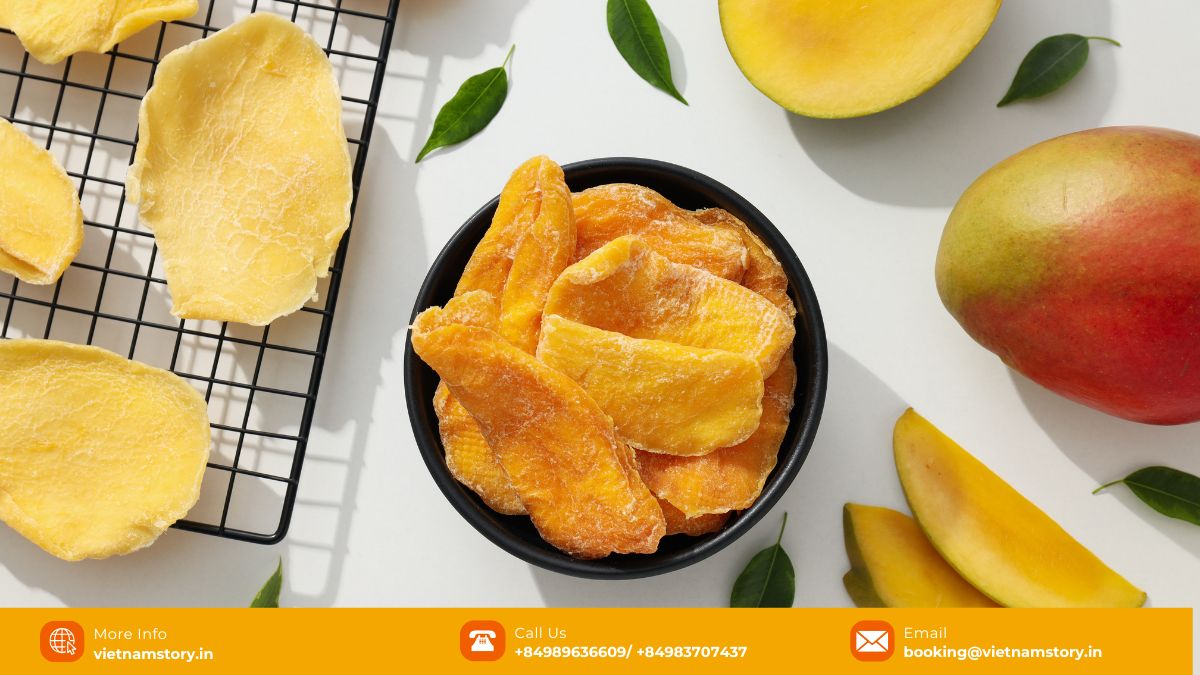
The Future of Fruits in Vietnam: Trends and Innovations
The Vietnamese fruit industry is dynamic:
- Sustainable Practices: Increasing focus on VietGAP and organic farming.
- Export Growth: Expanding markets for high-quality Vietnamese fruits globally.
- Value-Added Products: More investment in processing fruits into juices, purees, dried snacks, and frozen goods.
- Agritourism: Fruit orchards, especially in the Mekong Delta, are becoming popular destinations for tourists seeking authentic experiences.
- High-Value Cultivation: Investment in premium varieties, like specific types of Durian (e.g., Musang King) or Mangoes.
Conclusion
The incredibly diverse world of fruits in Vietnam is a vibrant reflection of the country’s rich agricultural heritage, favourable tropical climate, and deep cultural traditions like Tet. From the common Mango and Banana to exotic treasures like Durian, Mangosteen, and Rambutan, exploring these natural delights is a highlight for any traveler, offering a true taste of Vietnamese culture and cuisine. Learning how to eat them like a local adds to the fun! As you plan your travel in Vietnam, especially if visiting from India, be adventurous and dive into the colourful, flavourful bounty that awaits in Vietnam’s markets and orchards. It’s an experience that will surely delight your senses.










